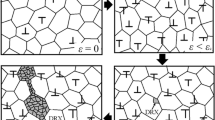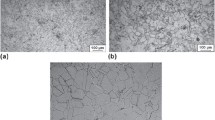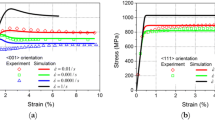Abstract
Generally, the obvious work hardening, dynamic recrystallization (DRX), and dynamic recovery behaviors can be found during hot deformation of Ni-based superalloys. In the present study, the classical dislocation density theory is improved by introducing a new dislocation annihilation item to represent the influences of DRX on dislocation density evolution for a Ni-based superalloy. Based on the improved dislocation density theory, the peak strain corresponding to peak stress and the critical strain for initiating DRX can be determined, and the improved DRX kinetics equations and grain size evolution models are developed. The physical framework and algorithmic idea of the improved dislocation density theory are clarified. Moreover, the deformed microstructures are characterized and quantitatively correlated to validate the improved dislocation density theory. It is found that the improved dislocation density-based models can precisely characterize hot deformation and DRX behaviors for the studied superalloy under the tested conditions.










Similar content being viewed by others
References
Y.C. Lin and X.M. Chen: A critical review of experimental results and constitutive descriptions for metals and alloys in hot working. Mater. Des. 32, 1733 (2011).
Y.C. Lin, D.X. Wen, Y.C. Huang, X.M. Chen, and X.W. Chen: A unified physically based constitutive model for describing strain hardening effect and dynamic recovery behavior of a Ni-based superalloy. J. Mater. Res. 30, 3784 (2015).
H.Q. Liang, H.Z. Guo, Y.Q. Ning, X.N. Peng, C. Qin, Z.F. Shi, and Y. Nan: Dynamic recrystallization behavior of Ti–5Al–5Mo–5V–1Cr–1Fe alloy. Mater. Des. 63, 798 (2015).
G.Z. Quan, W.Q. Lv, Y.P. Mao, Y.W. Zhang, and J. Zhou: Prediction of flow stress in a wide temperature range involving phase transformation for as-cast Ti–6Al–2Zr–1Mo–1V alloy by artificial neural network. Mater. Des. 50, 51 (2013).
M.H. Maghsoudi, A. Zarei-Hanzaki, P. Changizian, and A. Marandi: Metadynamic recrystallization behavior of AZ61 magnesium alloy. Mater. Des. 57, 487 (2014).
Y.H. Liu, Y.Q. Ning, Z.K. Yao, and M.W. Fu: Hot deformation behavior of the 1.15C–4.00Cr–3.00V–6.00W–5.00Mo powder metallurgy high speed steel. Mater. Des. 54, 854 (2014).
A. Momeni, G.R. Ebrahimi, and H.R. Faridi: Effect of chemical composition and processing variables on the hot flow behavior of leaded brass alloys. Mater. Sci. Eng., A 626, 1 (2015).
G.Z. Quan, Y.P. Mao, G.S. Li, W.Q. Lv, Y. Wang, and J. Zhou: A characterization for the dynamic recrystallization kinetics of as-extruded 7075 aluminum alloy based on true stress–strain curves. Comput. Mater. Sci. 55, 65 (2012).
S. Serajzadeh, S. Ranjbar Motlagh, S.M.H. Mirbagheri, and J.M. Akhgar: Deformation behavior of AA2017-SiCp in warm and hot deformation regions. Mater. Des. 67, 318 (2015).
T. Sakai, A. Belyakov, R. Kaibyshev, H. Miura, and J.J. Jonas: Dynamic and post-dynamic recrystallization under hot cold and severe plastic deformation conditions. Prog. Mater. Sci. 60, 130 (2014).
L. Gambirasio and E. Rizzi: An enhanced Johnson–Cook strength model for splitting strain rate and temperature effects on lower yield stress and plastic flow. Comput. Mater. Sci. 113, 231 (2016).
A.R. Abbasi-Bani, A. Zarei-Hanzaki, M.H. Pishbin, and N. Haghdadi: A comparative study on the capability of Johnson–Cook and Arrhenius-type constitutive equations to describe the flow behavior of Mg–6Al–1Zn alloy. Mech. Mater. 71, 52 (2014).
Y.C. Lin, M.S. Chen, and J. Zhong: Constitutive modeling for elevated temperature flow behavior of 42CrMo steel. Comput. Mater. Sci. 42, 470 (2008).
Y.C. Lin, D.X. Wen, J. Deng, G. Liu, and J. Chen: Constitutive models for high-temperature flow behaviors of a Ni-based superalloy. Mater. Des. 59, 115 (2014).
R. Bobbili, A. Paman, and V. Madhu: High strain rate tensile behavior of Al–4.8Cu–1.2Mg alloy. Mater. Sci. Eng., A 651, 753 (2016).
L. Chen, G.Q. Zhao, and J.Q. Yu: Hot deformation behavior and constitutive modeling of homogenized 6026 aluminum alloy. Mater. Des. 75, 57 (2015).
D. Trimble and G.E. O’Donnell: Constitutive modelling for elevated temperature flow behaviour of AA7075. Mater. Des. 76, 150 (2015).
D.M. Collins and H.J. Stone: A modelling approach to yield strength optimisation in a nickel–base superalloy. Int. J. Plast. 54, 96 (2014).
L.T. Li, Y.C. Lin, L. Li, L.M. Shen, and D.X. Wen: Three-dimensional crystal plasticity finite element simulation of hot compressive deformation behaviors of 7075 Al alloy. J. Mater. Eng. Perform. 24, 1294 (2015).
A. He, G.L. Xie, X.Y. Yang, X.T. Wang, and H.L. Zhang: A physically-based constitutive model for a nitrogen alloyed ultralow carbon stainless steel. Comput. Mater. Sci. 98, 64 (2015).
Y.H. Liu, Y.Q. Ning, Y. Nan, H.Q. Liang, Y. Li, and Z.L. Zhao: Characterization of hot deformation behavior and processing map of FGH4096–GH4133B dual alloys. J. Alloys Compd. 633, 505 (2015).
C. Zhang, L.W. Zhang, M.F. Li, W.F. Shen, and S.D. Gu: Effects of microstructure and γ′ distribution on the hot deformation behavior for a powder metallurgy superalloy FGH96. J. Mater. Res. 29, 2799 (2014).
Y.C. Lin, X.Y. Wu, X.M. Chen, J. Chen, D.X. Wen, J.L. Zhang, and L.T. Li: EBSD study of a hot deformed nickel-based superalloy. J. Alloys Compd. 640, 101 (2015).
D.X. Wen, Y.C. Lin, J. Chen, X.M. Chen, J.L. Zhang, Y.J. Liang, and L.T. Li: Work-hardening behaviors of typical solution–treated and aged Ni-based superalloys during hot deformation. J. Alloys Compd. 618, 372 (2015).
J.B. Le Graverend, J. Cormier, F. Gallerneau, P. Villechaise, S. Kruch, and J. Mendez: A microstructure-sensitive constitutive modeling of the inelastic behavior of single crystal nickel-based superalloys at very high temperature. Int. J. Plast. 59, 55 (2014).
F.M. Shore, M. Morakabati, S.M. Abbasi, A. Momeni, and R. Mahdavi: Hot ductility of Incoloy 901 produced by vacuum arc remelting. ISIJ Int. 54, 1353 (2014).
H.B. Zhang, K.F. Zhang, S.S. Jiang, and Z. Lu: The dynamic recrystallization evolution and kinetics of Ni–18.3Cr–6.4Co–5.9W–4Mo–2.19Al–1.16Ti superalloy during hot deformation. J. Mater. Res. 30, 1029 (2015).
S.S. Satheesh Kumar, T. Raghu, P.P. Bhattacharjee, G. Appa Rao, and U. Borah: Constitutive modeling for predicting peak stress characteristics during hot deformation of hot isostatically processed nickel-base superalloy. J. Mater. Sci. 50, 6444 (2015).
M. Fisk, J.C. Ion, and L.E. Lindgren: Flow stress model for IN718 accounting for evolution of strengthening precipitates during thermal treatment. Comput. Mater. Sci. 82, 531 (2014).
Y. Bergström: A dislocation model for the stress-strain behaviour of polycrystalline α-Fe with special emphasis on the variation of the densities of mobile and immobile dislocations. Mater. Sci. Eng. 5, 193 (1970).
Y. Bergström: The plastic deformation of metals—A dislocation model and its applicability. Rev. Powder Metall. Phys. Ceram. 2, 79 (1983).
U.F. Kocks and H. Mecking: Physics and phenomenology of strain hardening: The FCC case. Prog. Mater. Sci. 48, 171 (2003).
H. Mecking and U.F. Kocks: Kinetics of flow and strain-hardening. Acta Metall. 29, 1865 (1981).
M. Bambach, S. Heppner, D. Steinmetz, and F. Roters: Assessing and ensuring parameter identifiability for a physically-based strain hardening model for twinning-induced plasticity. Mech. Mater. 84, 127 (2015).
Y. Estrin, L.S. Tóth, A. Molinari, and Y. Bréchet: A dislocation-based model for all hardening stages in large strain deformation. Acta Mater. 46, 5509 (1998).
E.I. Galindo-Nava and P.E.J. Rivera-Díaz-del-Castillo: Thermostatistical modelling of hot deformation in FCC metals. Int. J. Plast. 47, 202 (2013).
Y. Estrin, A. Molotnikov, C. Davies, and R. Lapovok: Strain gradient plasticity modelling of high-pressure torsion. J. Mech. Phys. Solids 56, 1186 (2008).
E. Hug, P.A. Dubos, C. Keller, L. Duchêne, and A.M. Habraken: Size effects and temperature dependence on strain-hardening mechanisms in some face centered cubic materials. Mech. Mater. 91, 136 (2015).
Y.Q. Ning, X. Luo, H.Q. Liang, H.Z. Guo, J.L. Zhang, and K. Tan: Competition between dynamic recovery and recrystallization during hot deformation for TC18 titanium alloy. Mater. Sci. Eng., A 635, 77 (2015).
D. Wedberg and L.E. Lindgren: Modelling flow stress of AISI 316L at high strain rates. Mech. Mater. 91, 194 (2015).
T. Csanádi, N.Q. Chinh, J. Gubicza, G. Vörös, and T.G. Langdon: Characterization of stress-strain relationships in Al over a wide range of testing temperatures. Int. J. Plast. 54, 178 (2014).
P. Shanthraj and M.A. Zikry: Dislocation density evolution and interactions in crystalline materials. Acta Mater. 59, 7695 (2011).
H.S. Leung, P.S.S. Leung, B. Cheng, and A.H.W. Ngan: A new dislocation-density-function dynamics scheme for computational crystal plasticity by explicit consideration of dislocation elastic interactions. Int. J. Plast. 67, 1 (2015).
B. Babu and L.E. Lindgren: Dislocation density based model for plastic deformation and globularization of Ti–6Al–4V. Int. J. Plast. 50, 94 (2013).
E.D. Cyr, M. Mohammadi, R.K. Mishra, and K. Inal: A three dimensional (3D) thermos-elasto-viscoplastic constitutive model for fcc polycrystals. Int. J. Plast. 70, 166 (2015).
M. Borodachenkova, F. Barlat, W. Wen, A. Bastos, and J.J. Grácio: A microstructure-based model for describing the material properties of Al–Zn alloys during high pressure torsion. Int. J. Plast. 68, 150 (2015).
A. Marandi, R. Zarei-Hanzaki, A. Zarei-Hanzaki, and H.R. Abedi: Dynamic recrystallization behavior of new transformation–twinning induced plasticity steel. Mater. Sci. Eng., A 607, 397 (2014).
H.Q. Liang and H.Z. Guo: The integrated influence on hot deformation of dual-phase titanium alloys incorporating dynamic recrystallization evolution and α/β phase transformation. Mater. Lett. 151, 57 (2015).
H.B. Zhang, K.F. Zhang, H.P. Zhou, Z. Lu, C.H. Zhao, and X.L. Yang: Effect of strain rate on microstructure evolution of a nickel-based superalloy during hot deformation. Mater. Des. 80, 51 (2015).
Y. Estrin and H. Mecking: A unified phenomenological description of work hardening and creep based on one-parameter models. Acta Metall. 32, 57 (1984).
G. Engberg and L. Lissel: A physically based microstructure model for predicting the microstructural evolution of a C–Mn steel during and after hot deformation. Steel Res. Int. 79, 47 (2008).
H.W. Li, C. Wu, and H. Yang: Crystal plasticity modeling of the dynamic recrystallization of two-phase titanium alloys during isothermal processing. Int. J. Plast. 51, 271 (2013).
R. Ding and Z.X. Guo: Coupled quantitative simulation of microstructural evolution and plastic flow during dynamic recrystallization. Acta Mater. 49, 3163 (2001).
E. Popova, Y. Staraselski, A. Brahme, R.K. Mishra, and K. Inal: Coupled crystal plasticity-probabilistic cellular automata approach to model dynamic recrystallization in magnesium alloys. Int. J. Plast. 66, 85 (2015).
T. Takaki, C. Yoshimoto, A. Yamanaka, and Y. Tomita: Multiscale modeling of hot-working with dynamic recrystallization by coupling microstructure evolution and macroscopic mechanical behavior. Int. J. Plast. 52, 105 (2014).
Y.C. Lin, Y.X. Liu, M.S. Chen, M.H. Huang, X. Ma, and Z.L. Long: Study of static recrystallization behavior in hot deformed Ni-based superalloy using cellular automaton model. Mater. Des. 99, 107 (2016).
Y. Estrin: Dislocation-density-related constitutive modeling. In Unified Constitutive Laws of Plastic Deformation, A.S. Krausz and K. Krausz, eds. (San Diego: Academic Press, 1996); p. 69.
L.E. Lindgren, K. Domkin, and S. Hansson: Dislocations, vacancies and solute diffusion in physical based plasticity model for AISI 316L. Mech. Mater. 40, 907 (2008).
H. Mecking, U.F. Kocks, and C. Hartig: Taylor factors in materials with many deformation modes. Scr. Mater. 35, 465 (1996).
Y.X. Liu, Y.C. Lin, H.B. Li, D.X. Wen, X.M. Chen, and M.S. Chen: Study of dynamic recrystallization in a Ni-based superalloy by experiments and cellular automaton model. Mater. Sci. Eng., A 626, 432 (2015).
D.X. Wen, Y.C. Lin, J. Chen, J. Deng, X.M. Chen, J.L. Zhang, and M. He: Effects of initial aging time on processing map and microstructures of a nickel-based superalloy. Mater. Sci. Eng., A 620, 319 (2015).
Y.C. Lin, X.M. Chen, D.X. Wen, and M.S. Chen: A physically-based constitutive model for a typical nickel-based superalloy. Comput. Mater. Sci. 83, 282 (2014).
E.I. Galindo-Nava and P.E.J. Rivera-Díaz-del-Castillo: A thermostatistical theory of low and high temperature deformation in metals. Mater. Sci. Eng., A 543, 110 (2012).
D.X. Wen, Y.C. Lin, H.B. Li, X.M. Chen, J. Deng, and L.T. Li: Hot deformation behavior and processing map of a typical Ni-based superalloy. Mater. Sci. Eng., A 591, 183 (2014).
A. Laasraoui and J.J. Jonas: Prediction of steel flow stresses at high temperatures and strain rates. Metall. Trans. A 22, 1545 (1991).
E.I. Galindo-Nava and P.E.J. Rivera-Díaz-del-Castillo: A thermodynamic theory for dislocation cell formation and misorientation in metals. Acta Mater. 60, 4370 (2012).
E.O. Hall: The deformation and ageing of mild steel: III discussion of results. Proc. Phys. Soc. B 64, 747 (1951).
F. Chen, Z.S. Cui, J. Liu, W. Chen, and S.J. Chen: Mesoscale simulation of the high–temperature austenitizing and dynamic recrystallization by coupling a cellular automaton with a topology deformation technique. Mater. Sci. Eng., A 527, 5539 (2010).
B. Derby: The dependence of grain size on stress during dynamic recrystallization. Acta Metall. Mater. 39, 955 (1991).
G.A. Henshall, M.E. Kassner, and H.J. McQueen: Dynamic restoration mechanisms in Al-5.8 At. Pct Mg deformed to large strains in the solute drag regime. Metall. Trans. A 23, 881 (1992).
M. Fukuhara and A. Sanpei: Elastic moduli and internal frictions of Inconel 718 and Ti–6Al–4V as a function of temperature. J. Mater. Sci. Lett. 12, 1122 (1993).
H.J. Frost and M.F. Ashby: Deformation Mechanism Maps: The Plasticity and Creep of Metals and Ceramics, 1st ed. (Pergamon Press, Oxford, 1982); p. 20.
ACKNOWLEDGMENTS
This work was supported by the National Natural Science Foundation Council of China (Grant Nos. 51375502, 51305466), the National Key Basic Research Program (Grant No. 2013CB035801), the Project of Innovation-driven Plan in Central South University (Grant No. 2016CX008), and the Natural Science Foundation for Distinguished Young Scholars of Hunan Province (Grant No. 2016JJ1017).
Author information
Authors and Affiliations
Corresponding author
Rights and permissions
About this article
Cite this article
Lin, Y.C., Wen, DX., Chen, MS. et al. Improved dislocation density-based models for describing hot deformation behaviors of a Ni-based superalloy. Journal of Materials Research 31, 2415–2429 (2016). https://doi.org/10.1557/jmr.2016.220
Received:
Accepted:
Published:
Issue Date:
DOI: https://doi.org/10.1557/jmr.2016.220




